The building boom of 1892 brought the construction of St. Louis Park’s first hotels, occupied mostly by employees of the Monitor Drill and other factory workers, as well as the men building the new factories. The hotels were all in the same general area of town.
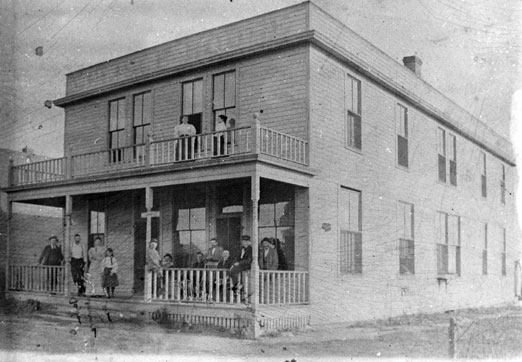 The Belisle House was the first boardinghouse in the area, dating to 1891. It was located on Brownlow, across from the Methodist Church, east of Reiss’s.
The Belisle House was the first boardinghouse in the area, dating to 1891. It was located on Brownlow, across from the Methodist Church, east of Reiss’s.
 The Great Northern Hotel was built in 1891 by T.B. Walker. The largest of the hotels, it had 25-30 rooms and a dining room. It was located at 6900 Lake Street (at Walker), on a hill north of the Monitor Works [later the site of Reiss’s Restaurant]. It was first operated by Mr. Peterson and later by Mrs. John Duff and Mrs. Bruemmer (1903-1908). (It was apparently also known as Duff’s?) Mrs. Duff sold it to the Drakes, who sold it to a lady from Minneapolis. Three weeks later it burned to the ground, in 1912.
The Great Northern Hotel was built in 1891 by T.B. Walker. The largest of the hotels, it had 25-30 rooms and a dining room. It was located at 6900 Lake Street (at Walker), on a hill north of the Monitor Works [later the site of Reiss’s Restaurant]. It was first operated by Mr. Peterson and later by Mrs. John Duff and Mrs. Bruemmer (1903-1908). (It was apparently also known as Duff’s?) Mrs. Duff sold it to the Drakes, who sold it to a lady from Minneapolis. Three weeks later it burned to the ground, in 1912.
1891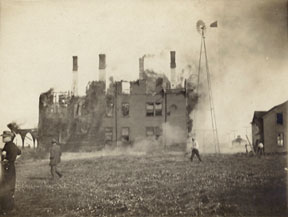
Great Northern Hotel Fire
St. Louis Park Hotel?
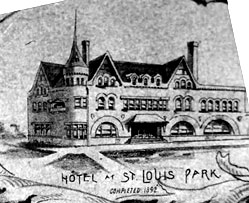
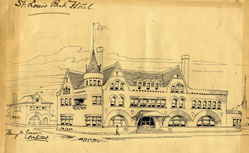
On the 1892 map of St. Louis Park, there are sketches of the hotels and industries in the town. One of these is simply labeled “Hotel at St. Louis Park.” (first sketch above). We find the same building in a sketch made by the architect, Henry W. Jones. On that sketch it is called St. Louis Park Hotel. The St. Louis Park Historical Society does not have a picture of this hotel.
The Commers House was called the Blind Pig because of the illegal whisky manufactured therein. The Village band practiced in the hotel dining room. The last family to live in the Blind Pig was the Lockway family. It was purchased by Herbert Carleton, who started a real estate business in 1901 and had been in the Park since 1904. It was torn down in the 20’s to make way for the Dan Patch tracks, although one source remembers that Carleton built his own home on the property.
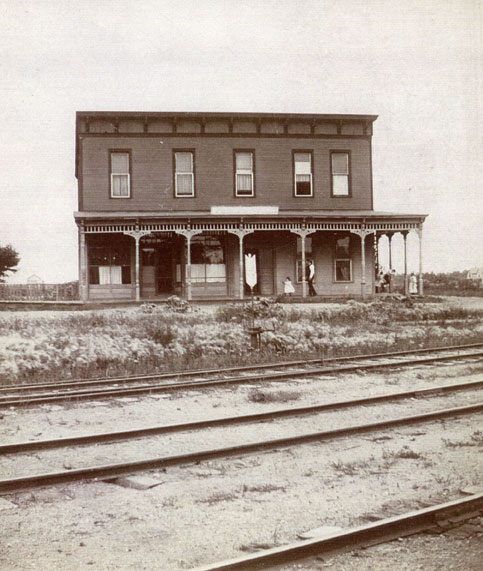 The Walker-owned St. Louis Park Hotel had 8-10 rooms and was located at Grant Street north of the tracks, across from the M&SL depot [36th and Brunswick]. It was managed by Henry Keller (a Swiss native) and his wife Rosa (from German), who came to St. Louis Park from New Ulm in 1899. Rose was Doc Brown’s mother-in-law. Rosa did the cooking and prepared lunches that the workers could carry to work. The morning and evening meals were served in the dining room, where Rose and her sisters waited on tables. The room rate was $3 per week. It closed after 1928, and in 1933, Mr. C.A. Chrisidis requested permission from the Village Council to “wreck” it.
The Walker-owned St. Louis Park Hotel had 8-10 rooms and was located at Grant Street north of the tracks, across from the M&SL depot [36th and Brunswick]. It was managed by Henry Keller (a Swiss native) and his wife Rosa (from German), who came to St. Louis Park from New Ulm in 1899. Rose was Doc Brown’s mother-in-law. Rosa did the cooking and prepared lunches that the workers could carry to work. The morning and evening meals were served in the dining room, where Rose and her sisters waited on tables. The room rate was $3 per week. It closed after 1928, and in 1933, Mr. C.A. Chrisidis requested permission from the Village Council to “wreck” it.
The Hinkle Hotel was built by the Milwaukee Road, on Brunswick and 36th Street. It was two stories and had 22 rooms, a living room, dining room, and bar. It also had a patio where the male boarders entertained their girlfriends on Saturday afternoons. The hotel had no indoor plumbing, however, and one former boarder remembers that they would go downtown to the Lumber Exchange building where they could take a bath for a quarter. Owner John Hinkel had liquor licenses from at least 1909 to 1915. In 1909, he requested permission to put a curtain across the room used for a saloon and shut off all parts of liquor and to use such room as a hotel office on Sundays.
Mrs. Dagmar Nelson ran a boarding house at the corner of Pleasant Avenue [Wooddale] and Hamilton [3456 Wooddale – built in 1887, it is the fourth oldest home still standing according to city tax records]. It may be that Mrs. Nelson began renting her home after her husband Nels died. They had one daughter, Dorothea Nelson Seirup, who lived at Excelsior and Brookside until 1942. Mrs. Nels Nelson, and Harold and Mary Nelson lived in the house in 1933. Dorothea’s son, George Seirup, was living at the Wooddale house in 1942. The Wooddale house is now a fourplex, with renters coming and going.
One of Mrs. Nelson’s boarders was Eddie Rickenbacker, who worked on his racing car in a blacksmith shop by the Creosote plant and won several races at the State Fair. He became a hero in World War I, a famous racecar driver, and later President of Eastern Airlines.
Hotels, as well as private houses, were still primitive. The outhouse was in back, or you could use the “thunder mug” under your bed. Coal and wood-burning stoves were used for heating and cooking, and lighting was by kerosene lamps. Water had to be hand-pumped from an outside well.
